| Pages:
1
..
3
4
5
6
7
..
11 |
nux vomica
Hazard to Others
  
Posts: 267
Registered: 18-7-2013
Member Is Offline
Mood: No Mood
|
|
Quote: Originally posted by Hennig Brand  | I have made a few assumptions in my time too and reaped the rewards. 
From the above picture it looks as though your power supply is being supplied by only two AA batteries. That in itself tells a lot about the limited
current supplying capability of the power supply. Power supplies have losses, usually quite significant especially with small power supplies, but lets
assume for a minute that yours has no losses (Power In = Power Out). Lets assume you can pull 1A from the two AA batteries at 3V. Using conservation
of energy, power in is 3V * 1A = 3W, so at 4500V the current drawn could be a maximum of 3W / 4500V = ca. 0.67mA. At 4500V the 5 Mohm Volt meter would
draw, 4500V / 5 000 000 ohm = 0.9mA (0.9mA > 0.67mA). I went through these same problems when I was using the bug zapper supplies.
|
I see what you say about the power supply not being able pushover 2800v with the meter connected that's why I've been charging with the negative wire
connected then touching the positive wire to get a reading, after 11 seconds from fully discharged the reading averages 4200v when I've tested it
multiple times on the bench not accurate I know for data collection but its the best that I can do for now. cheers nuxy
[Edited on 11-6-2015 by nux vomica]
|
|
|
jock88
National Hazard
   
Posts: 505
Registered: 13-12-2012
Member Is Offline
Mood: No Mood
|
|
Most commercial ebw detonators are made with PETN (AFAIK). This PETN has to be very small crystals to increase sensitivity.
On sensitive is ETN compared to normal PETN and the very fine crystal PETN?
|
|
|
nux vomica
Hazard to Others
  
Posts: 267
Registered: 18-7-2013
Member Is Offline
Mood: No Mood
|
|
Succsess with Petn
Managed to get Petn to detonate with my ebw the first time I tried.
The Petn acetone mix was poured into cold water that was being stirred rapidly , the precipitated Petn was vacuum filtered then left to dry ,the dry
Petn was fine and free flowing powder.
I used the same setup as last time 7 meter coax 200mm twin core, copper bridgewire 0.030mm dia x 1.6mmlong 8mm id alloy tube with the main charge 0.70
grams compressed to 1.31 grams cubic centimetres and 0.10 grams loose on top.
Capacitor bank was charged for 11 seconds and pezio button pushed detonation was instantaneous and it did seem louder than etn.
[Edited on 12-6-2015 by nux vomica]
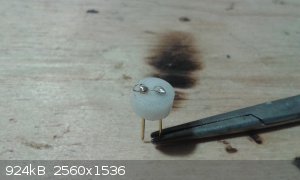 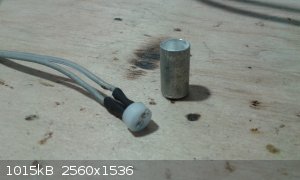  
|
|
|
Hennig Brand
International Hazard
    
Posts: 1284
Registered: 7-6-2009
Member Is Offline
Mood: No Mood
|
|
Good job, yeah, PETN is at least a little more insensitive to initiation than ETN all other things being equal. However, either PETN or ETN can be
easily initiated by EBW as long as the packing density is kept low around the bridgewire and yes the finer the crystals the greater the sensitivity
also. There are specialized techniques used commercially to get the PETN particle size extremely small. ETN works fine, but PETN is much more storage
stable and at least a little less sensitive to initiation both of which are advantages for a commercial product. In extreme environments with high
temperatures ETN's low melting point (60-61C) would be a real problem too.
BTW, on the last page when I suggested putting resistors in series to make a high voltage resistor divider out of lower voltage resistor types, be
aware that the voltage drop across each resistor will only be the same if the resistance of each resistor in the series string is the same. The
voltage drop across a higher value resistor, and therefore also the power dissipated, will be greater than for a lower value resistor in a series
string and could be enough to damage or completely destroy the resistor if not of the appropriate type with adequate voltage and power ratings.
[Edited on 12-6-2015 by Hennig Brand]
"A risk-free world is a very dull world, one from which we are apt to learn little of consequence." -Geerat Vermeij
|
|
|
nux vomica
Hazard to Others
  
Posts: 267
Registered: 18-7-2013
Member Is Offline
Mood: No Mood
|
|
Ebw shaped charge
I think I can get a shaped charge to work with my Ebw setup I formed a cone with a file in a piece of delrin on my lathe then pressed 0.70 grams of
etn on top then 0.10 loose on top same alloy tube and bridgewire setup but instead of soldering the lead wires to the coax I used jst connectors I
used them in rc helicopters and planes so I've got a good supply on hand.
I didn't form a copper cone to fit so the charge was unlined and touching the 2mm s/s plate but it blew a nice hole clean through so it seems to
detonate and focus the waves to form a copper liner into a penetrator even in such a short explosive length (calculated 8mm long ).
hopefully next post will be a successful shape charge shot cheers nuxy.
[Edited on 14-6-2015 by nux vomica]
   
[Edited on 14-6-2015 by nux vomica]

|
|
|
nux vomica
Hazard to Others
  
Posts: 267
Registered: 18-7-2013
Member Is Offline
Mood: No Mood
|
|
EFP shaped charge.
Just had a awesome result using my ebw setup to fire a EFP shaped charge.
I saw some 10mm s/s rivnuts at work and thought they would be a great shaped charge outer container, I used 1.2 grams of etn compressed to 1.3 grams
c/c plus 0.1 on top for a total of 1.3 grms of etn the copper dish was 6.25mm rad, 0.8mm thick and 11.5 mm dia ,bridge wire 0.030 dia x 1.6mm long,
coax 7 meters with 200mm twin core on the end connecting with a jst to the shaped charge I don't have voltage level but counted to 15 seconds then
pushed the piezo button and detonation was instantaneous.
I used 50mm standoff from the 6mm thick mild steel plate and the dia of the hole measured 3.48mm next time I will use thicker plate cause it punched
through 6mm very easily
Cheers nuxy.
 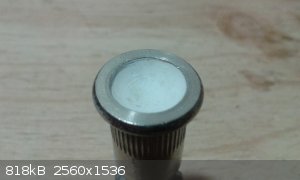 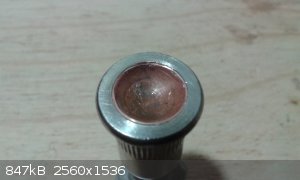 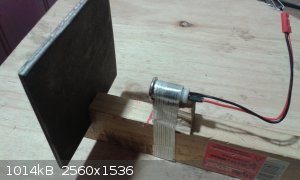
Exit side   
This is the shaped charge side

[Edited on 16-6-2015 by nux vomica]
|
|
|
Hennig Brand
International Hazard
    
Posts: 1284
Registered: 7-6-2009
Member Is Offline
Mood: No Mood
|
|
Very professional looking again and I also like those "rivnuts", they look like they make great casings. With the amount of curvature you are using I
think you may be starting to get into the transition zone between Munroe effect and EFP. At the very least you will have a very narrow and elongated
projectile, which is a good thing from a penetration perspective. From what I have seen an EFP liner would normally have a depth of curvature
somewhere around 20% the diameter of the liner, or often much less even, while yours is reported to be (6.25mm - sqrt(6.25mm^2 - 5.75mm^2)) / 11.5mm *
100% = ca. 33%.....(if I haven't messed up). The standoff used also tells a story, it is only about 4 & 1/3 times the charge diameter, which is a
very short distance for an EFP to form. The hole produced is also quite small in diameter for an EFP, especially at such close range. It is an
interesting test all things considered.
If something works it works, but still you are flying blind with your charging circuit since you have no way of telling what the capacitor bank
voltage is. Here is a circuit I found online a while back on the following site somewhere I believe:
http://www.sebaseraelettronica.altervista.org/

Overall the design is not suitable for an EBW system, especially since he was using huge slow electrolytic capacitors of fairly low voltage and high
capacitance. However, the voltage indicator part of the circuit, built around an lm358 operational amplifier used as a comparator, looks like it would
work well. In conjunction with a voltage divider it could light an led when the capacitor bank voltage rose above a set point value.
Alternatively one of these could be ordered. I ordered one so that I could stop using a multimeter. These little panel meters are small and can be
installed permanently in the blasting box. They can be used in conjunction with a suitable voltage divider to measure high voltages.
http://www.ebay.ca/itm/201130716977?_trksid=p2057872.m2749.l...

If you want to prevent putting an extra load on the little power supply, you could have the voltage divider circuit & voltage meter only in
circuit when a momentary push button switch is pressed. This also gives you a safe way to discharge any remaining charge in the capacitor bank and
prevent shocking experiences. 
[Edited on 17-6-2015 by Hennig Brand]
"A risk-free world is a very dull world, one from which we are apt to learn little of consequence." -Geerat Vermeij
|
|
|
nux vomica
Hazard to Others
  
Posts: 267
Registered: 18-7-2013
Member Is Offline
Mood: No Mood
|
|
I actually have some of those power meters but they are two wire 30volts , I am getting around to a working voltage measuring setup but as always
time and trying to do to many other things gets in the way. 
I cut the 6mm plate in half through the shaped charge hole the entry side is from the top, I like the copper coating on the inside looks cool , might
call it a Dolezal charge cause it identifies itself as a efp charge.
cheers nuxy.
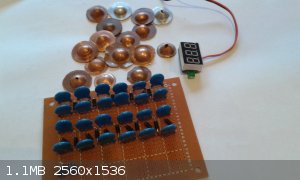 
[Edited on 17-6-2015 by nux vomica]
|
|
|
Hennig Brand
International Hazard
    
Posts: 1284
Registered: 7-6-2009
Member Is Offline
Mood: No Mood
|
|
I see you have a voltage multiplier constructed, looks good. I went with the three wire meter so that the sensing input and the power input for the
meter would be separate. Not sure exactly what kind of load those panel meters present even with just the sensing line, but a two wire will also draw
current to run the meter from the sensing wire and with a very low current, high voltage, voltage divider current draw needs to be kept to a minimum.
If keeping the power supply as physically small as possible is a priority using lower voltage ceramic caps would make a huge difference. The voltage
multiplier takes up a large portion of the total size of the supply. I just received 200, 10nF, 2kV ceramic capacitors which cost me about $4.50
Canadian. I used 3kV, 10nF, ceramic caps when I made my voltage multiplier, but 2kV, 10nF, caps would have been more than enough since the supply
voltage to the multiplier is only around 500-550V. Look at the size difference between these two! (3kV, 10nF on the left & 2kV, 10nF, on the right
in the image)

[Edited on 17-6-2015 by Hennig Brand]
"A risk-free world is a very dull world, one from which we are apt to learn little of consequence." -Geerat Vermeij
|
|
|
nux vomica
Hazard to Others
  
Posts: 267
Registered: 18-7-2013
Member Is Offline
Mood: No Mood
|
|
Quote: Originally posted by nux vomica  | Just had a awesome result using my ebw setup to fire a EFP shaped charge.
I saw some 10mm s/s rivnuts at work and thought they would be a great shaped charge outer container, I used 1.2 grams of etn compressed to 1.3 grams
c/c plus 0.1 on top for a total of 1.3 grms of etn the copper dish was 6.25mm rad, 0.8mm thick and 11.5 mm dia ,bridge wire 0.030 dia x 1.6mm long,
coax 7 meters with 200mm twin core on the end connecting with a jst to the shaped charge I don't have voltage level but counted to 15 seconds then
pushed the piezo button and detonation was instantaneous.
I used 50mm standoff from the 6mm thick mild steel plate and the dia of the hole measured 3.48mm next time I will use thicker plate cause it punched
through 6mm easy
Tried the same setup at 50mm standoff but with 10mm thick m/s plate, punched through the 10mm plate and the carrot travelled 65 mm into the pine wood
block but it broke up into small fragments in the wood. 
The entry hole is quite messy and if you look there is a round ring where the front edge of the rivnut impacted, but the jet hole is offset to the
ring mark, I didn't think when I was drilling the bridgewire wire pin holes but they were a little offset from centre and I think its made the jet
slightly malformed and offset so I didn't get a cleaner entry hole cheers Nuxy.
[Edited on 19-6-2015 by nux vomica]
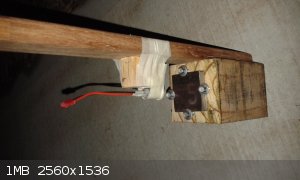  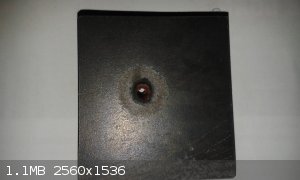
[Edited on 19-6-2015 by nux vomica] |
|
|
|
Hennig Brand
International Hazard
    
Posts: 1284
Registered: 7-6-2009
Member Is Offline
Mood: No Mood
|
|
You are getting excellent penetration, really almost too good for a regular EFP from what I have seen and especially at that amount of standoff. I am
interested in the depth of curvature of your liner. I know I calculated something above, but if you had a liner handy could you measure the depth of
the dish with a depth gauge? I have a depth gauge rod on a Vernier caliper, not sure what you have for tools.
No Voltage Multiplier?
An option to keep the power supply as small as possible could be to use no voltage multiplier stage at all and wind a HV transformer capable of
putting out the required output voltage all by itself. This option is more difficult for the amateur, however, since special techniques and materials
are required to wind transformers at several thousand volts or more. Winding a 400 or 500V transformer with regular techniques is no big deal, but
more than that can get tricky. A several thousand volt transformer would need to be vacuum potted in an insulating epoxy or something similar to
prevent internal arcing and shorting between windings. Special formers/bobbins are also normally used which likely would need to be made.
LCR Meter
Have a look at my new LCR (inductance, capacitance, resistance) meter. It is a fairly low priced model out of China, but so far it seems very good.
They can be a very useful piece of test equipment when doing these sorts of projects. The inductance meter can be very useful when designing
transformers and obviously inductors. The capacitance meter can be used as a test, along with other tests if available, to help determine the
condition of capacitors (e.g. usually one cap goes bad at a time in a pulsed power capacitor bank and a capacitance meter can usually be used to
identify it). As long as they are not overcharged, or repeatedly shorted into a very low impedance load (e.g. screwdriver across charged capacitor,
short blasting lines also put a lot more strain on the capacitors), I think our pulse capacitors will last a very long time given the very low usage.
Tesla coil capacitor banks, on the other hand, do occasionally have capacitors "die" from what I have read. There are many uses for an LCR meter, I
recommend one.
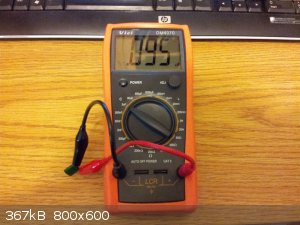
[Edited on 20-6-2015 by Hennig Brand]
"A risk-free world is a very dull world, one from which we are apt to learn little of consequence." -Geerat Vermeij
|
|
|
nux vomica
Hazard to Others
  
Posts: 267
Registered: 18-7-2013
Member Is Offline
Mood: No Mood
|
|
Took some measurements for you hennig I made a mistake with the copper thickness its actually 0.6mm not 0.80mm there must have been a burr on the edge
I didn't see.
Diameter is 11.41mm overall height is 3.17mm and weight 0.60 grams the ball diameter is 12.50mm.
Cheers nuxy.
[Edited on 20-6-2015 by nux vomica]
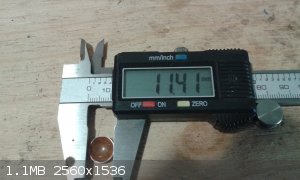   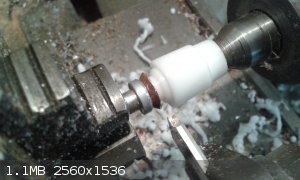
|
|
|
nux vomica
Hazard to Others
  
Posts: 267
Registered: 18-7-2013
Member Is Offline
Mood: No Mood
|
|
Couldn't help myself just had to try and shoot that liner through something, managed to make it through 16mm m/s plate just  .The standoff was 50mm and the shell s/s rivnut. .The standoff was 50mm and the shell s/s rivnut.
Used 1.2 grams PETN as im still waiting for my batch of etn to dry +0.1 PETN on top, 0.030mm dia copper wire and I've made the length 2mm, I have
tested this length and I haven't had a misfire yet and it makes it a bit easier to solder the wire on the pins, sorry I promise to work on voltage
measurement soon  so I charged the cap bank for 15 seconds and pushed the piezio
detonation was instantaneous (as usual) funny thing is the support pole for the charge is only screwed on and its never blown off and there is hardly
any fragment damage to it ? so I charged the cap bank for 15 seconds and pushed the piezio
detonation was instantaneous (as usual) funny thing is the support pole for the charge is only screwed on and its never blown off and there is hardly
any fragment damage to it ?
I wonder if I change the standoff whether it will give better penetration or maybe 1.2 grams of PETN can only just penetrate that far.
Cheers Nuxy.
 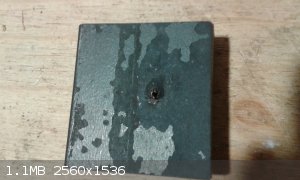  
[Edited on 20-6-2015 by nux vomica]
|
|
|
Hennig Brand
International Hazard
    
Posts: 1284
Registered: 7-6-2009
Member Is Offline
Mood: No Mood
|
|
Interesting, the depth of curvature is in the upper range for an EFP but still within from what I have seen. The penetration is too much for an EFP
though and the target looks like it has been hit by a SC jet not a EFP. I am going to have to try a stronger casing for my next EFP test. I suppose
you are using pure nitric ester too which would make a difference.
Ok Nuxy, stop messing around, where is the picture of the actual liner you used? 
"A risk-free world is a very dull world, one from which we are apt to learn little of consequence." -Geerat Vermeij
|
|
|
nux vomica
Hazard to Others
  
Posts: 267
Registered: 18-7-2013
Member Is Offline
Mood: No Mood
|
|
Honestly it was the one in the vernier caliper photo no point letting it sit around 
|
|
|
Hennig Brand
International Hazard
    
Posts: 1284
Registered: 7-6-2009
Member Is Offline
Mood: No Mood
|
|
Here are a couple commercially produced EBW initiated mini shaped charges. The commercial model is getting no where near the penetration you are
getting and with much more explosive. The kind of penetration you are getting is more consistent with a jetting shaped charge not an EFP. I guess it
could be somewhere in between which I think is possible.
Attachment: Mini EBW Initiated EFP.pdf (29kB)
This file has been downloaded 564 times
Attachment: Mini EBW Initiated Shaped Charge.pdf (29kB)
This file has been downloaded 601 times
It just occurred to me that the optimum depth of curvature for an EFP liner would also be dependent on the velocity and pressure of the explosive. You
are using straight nitric ester, so of course the center of the liner has been accelerated much more than when slower explosives are used, stretching
and narrowing more before the detonation wave makes it to the bottom outer edge of the liner. The amount of pressure applied to the liner, work done
on the liner, per unit time is much greater with the pure nitric ester explosive. The deeper the dish the more contact time there is between the
explosive and liner for transfer of energy to the liner, also the more the explosive force will be directed towards the center of the liner and
towards the target, stretching and narrowing the projectile. The more stretched out, narrower, faster moving projectile will penetrate more steel,
which is the same as what is observed for Munroe effect SC jets when more powerful explosives are used for basically the same reasons. You are also
using a fairly deep dish, by any EFP standards. I think you have something closer to a Munroe effect shaped charge.
EFPs are typically a longer range type SC device with much less penetrating ability than a close range Munroe effect shaped charge. As a
generalization they normally make a much wider shallower hole than a Munroe effect SC, but can be used at great distances from the target.
[Edited on 20-6-2015 by Hennig Brand]
"A risk-free world is a very dull world, one from which we are apt to learn little of consequence." -Geerat Vermeij
|
|
|
nux vomica
Hazard to Others
  
Posts: 267
Registered: 18-7-2013
Member Is Offline
Mood: No Mood
|
|
I don't know anything about the mechanics of what is going on with shaped charges but I am pretty happy with the result, I've spun liners up on my
lathe and didn't get as good penetration as I am getting with hitting a ball bearing into the copper sheet.
Ive made a small batch of plastic ebw holders yesterday amongst assembling and firing that last charge I routed a new work holder for drilling the
pinholes in the threaded plastic its also good for holding the bridgewire when your soldering the connector wires on to the head . cheers nuxy
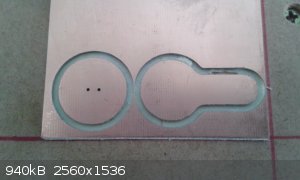     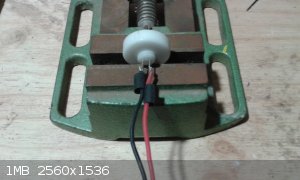 
[Edited on 21-6-2015 by nux vomica]
|
|
|
Hennig Brand
International Hazard
    
Posts: 1284
Registered: 7-6-2009
Member Is Offline
Mood: No Mood
|
|
Looks good, the way it all threads together is great. Using exploding bridge wire technology really is a pretty effective way to initiate explosives.
There are a few things to know, but after that the technology is pretty accessible.
Edit: I just wanted to add that a thiner liner would also be easier to accelerate (less inertia) and its resistance to being "shaped" would be less
too. So you have a very fast powerful explosive, a thin liner with deep curvature and a strong casing. It is more and more understandable what is
going on. Still impressive tests btw, glad you did them. I think I understand what has been happening with mine more now.
[Edited on 21-6-2015 by Hennig Brand]
"A risk-free world is a very dull world, one from which we are apt to learn little of consequence." -Geerat Vermeij
|
|
|
nux vomica
Hazard to Others
  
Posts: 267
Registered: 18-7-2013
Member Is Offline
Mood: No Mood
|
|
I feel that useing the ebw setup is safer from a assembly point of view as in not having to use azides etc, you can still have a accident but it
lessens the risk.
[Edited on 21-6-2015 by nux vomica]
|
|
|
Hennig Brand
International Hazard
    
Posts: 1284
Registered: 7-6-2009
Member Is Offline
Mood: No Mood
|
|
I agree at this point. Especially for the amateur the explosive and poison dangers associated with primary explosives is certainly much higher than
when only using secondary explosives and a EBW. The high voltage capacitor could be dangerous especially to the careless or uneducated, but only when
it is charged. Also my capacitor bank is only 4J when fully charged which I think is only mildly hazardous (unlikely to be anywhere near lethal) as
capacitor banks go.
Commercially is a different story, my perception is that for every primaryless EBW detonator used there are likely 1000 or even many more regular
electric detonators with primary explosives being used. For a blaster the regular commercial electric detonators are quite safe. Commerially EBW
detonators are mostly used in applications where precise timing and simultaniety is required. Even very good regular electric detonators are not very
fast and the timing varies a lot from one detonator to another compared to EBW detonators. For the amateur who is synthesising and loading his own
primaries, however, there can be considerable dangers. EBW detonators do eliminate a lot of dangers for the amateur in my opinion.
[Edited on 22-6-2015 by Hennig Brand]
"A risk-free world is a very dull world, one from which we are apt to learn little of consequence." -Geerat Vermeij
|
|
|
jock88
National Hazard
   
Posts: 505
Registered: 13-12-2012
Member Is Offline
Mood: No Mood
|
|
I think the nonex (spelling) tubing system is used alot.
|
|
|
nux vomica
Hazard to Others
  
Posts: 267
Registered: 18-7-2013
Member Is Offline
Mood: No Mood
|
|
Quote: Originally posted by Hennig Brand  | Looks good, the way it all threads together is great. Using exploding bridge wire technology really is a pretty effective way to initiate explosives.
There are a few things to know, but after that the technology is pretty accessible.
Edit: I just wanted to add that a thiner liner would also be easier to accelerate (less inertia) and its resistance to being "shaped" would be less
too. So you have a very fast powerful explosive, a thin liner with deep curvature and a strong casing. It is more and more understandable what is
going on. Still impressive tests btw, glad you did them. I think I understand what has been happening with mine more now.
| Quote: |
No probs I enjoy a challenge and its always nice when things work out hopefully other people can use the information .
Problem is that you always think you have climbed to the top of the mountain but the is always another peak in front of you , I'm getting a itch to
try and make a working foil slapper setup next. Nuxy. Nuxy.
[Edited on 22-6-2015 by nux vomica] |
|
|
|
|
Hennig Brand
International Hazard
    
Posts: 1284
Registered: 7-6-2009
Member Is Offline
Mood: No Mood
|
|
A slapper might be interesting, however, for regular blasting I think EBWs already have a high enough power requirement and are safe and reliable
enough for any regular blasting purposes. It would be interesting just for the hell of it though. Now if we can just separate the U-235 from the
U-238.......just kidding. From the little bit I know about it they normally use
plutonium in the implosion devices anyway. From the little bit I know about it they normally use
plutonium in the implosion devices anyway.
I just got one of the little three wire LED display voltage meters in the mail today. The one I have is drawing about 14.5-14.6mA through the power
line at 4.18V, and about 84uA through the sensing line at 4.18V which means the sensing circuitry has an input resistance of about 50kohms. The three
wire meters will work fine when used with a suitable voltage divider.
Here are a couple of images of the LED voltage meter. They did not focus well, but in reality the meter display is extremely clear and easy to read.
Since it is LED and not LCD it is very easy to read in the dark too. Not bad for about $1.70! I have one coming in green too.
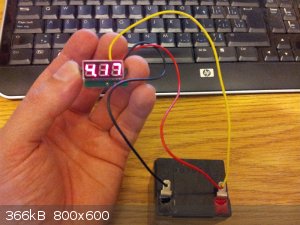 
[Edited on 24-6-2015 by Hennig Brand]
"A risk-free world is a very dull world, one from which we are apt to learn little of consequence." -Geerat Vermeij
|
|
|
nux vomica
Hazard to Others
  
Posts: 267
Registered: 18-7-2013
Member Is Offline
Mood: No Mood
|
|
Quote: Originally posted by Hennig Brand  | A slapper might be interesting, however, for regular blasting I think EBWs already have a high enough power requirement and are safe and reliable
enough for any regular blasting purposes. It would be interesting just for the hell of it though. Now if we can just separate the U-235 from the
U-238.......just kidding. From the little bit I know about it they normally use
plutonium in the implosion devices anyway. From the little bit I know about it they normally use
plutonium in the implosion devices anyway.
|
Meanwhile in my secret lab .

|
|
|
Hennig Brand
International Hazard
    
Posts: 1284
Registered: 7-6-2009
Member Is Offline
Mood: No Mood
|
|
Nice poster! I just checked and my laboratory centrifuge isn't large or powerful enough to enrich the uranium.  I guess our plans for world domination will have to wait. I guess our plans for world domination will have to wait. 
"A risk-free world is a very dull world, one from which we are apt to learn little of consequence." -Geerat Vermeij
|
|
|
| Pages:
1
..
3
4
5
6
7
..
11 |